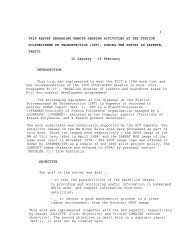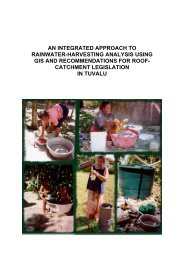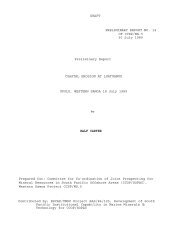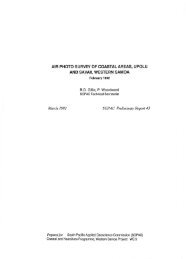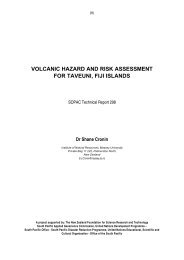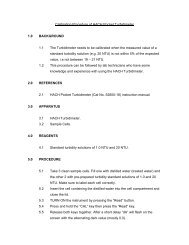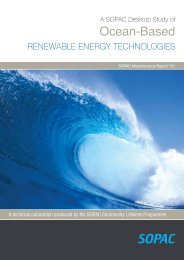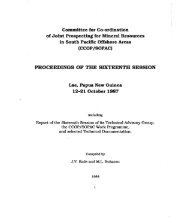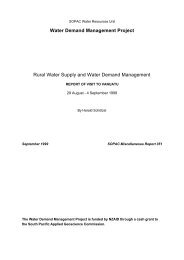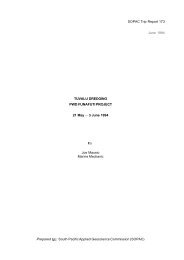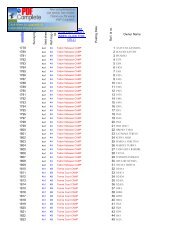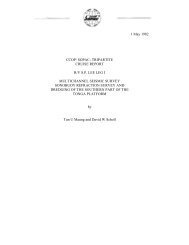Coastal engineering design of a rip-rap revetment ... - Up To - SOPAC
Coastal engineering design of a rip-rap revetment ... - Up To - SOPAC
Coastal engineering design of a rip-rap revetment ... - Up To - SOPAC
You also want an ePaper? Increase the reach of your titles
YUMPU automatically turns print PDFs into web optimized ePapers that Google loves.
Information on waves was also obtained from<br />
vertical, colour, 1992 aerial photog<strong>rap</strong>hs.<br />
Limestone rock strength was measured in-situ<br />
with an ELE Schmidt L-Type Hammer, while<br />
concrete strength was measured with an ELE<br />
Concrete Testing Hammer. Rip-<strong>rap</strong>/armourstone<br />
desc<strong>rip</strong>tion and <strong>revetment</strong> evaluation are based on<br />
criteria <strong>of</strong> CIRIA (1991) and Pilarczyk (1996),<br />
Latham (1998), Geological Society <strong>of</strong> London<br />
(GSL, 1999).<br />
Design information has been produced after<br />
Numerical Analysis with International Institute<br />
for Hydraulic Engineering, Delft University <strong>of</strong><br />
Technology (IHE-Delft, 1999), <strong>Coastal</strong> and River<br />
Engineering Support System (CRESS) and the U.<br />
S. Army Corps <strong>of</strong> Engineers, Automatic <strong>Coastal</strong><br />
Engineering System (ACES).<br />
Computations <strong>of</strong> <strong>rip</strong>-<strong>rap</strong> dimensions,<br />
armourstone stability and wave run-up are based<br />
on numerical equations <strong>of</strong> van der Meer (1987<br />
and 1998) and are modifications and<br />
improvements <strong>of</strong> the typical Hudson (1958)<br />
formula. Computations are therefore for random<br />
wave attack, more typical in the natural<br />
environments.<br />
3.1 The Problem Site<br />
3.0 RESULTS<br />
The site has the following characteristics:<br />
Development Characteristics<br />
�� the coastline is a heavily developed st<strong>rip</strong> <strong>of</strong><br />
land, with many residential and<br />
infrastructure facilities; and<br />
�� housing, seawalls, an adjacent airst<strong>rip</strong> for<br />
the national airport, a school, the<br />
telecommunications facility and several<br />
Government buildings front the adjacent<br />
and immediate shoreline.<br />
The Beach and Shorefront<br />
�� a medium to fine, carbonate sand beach,<br />
�� the beach is about 6 m wide with a 12-15°<br />
slope towards the sea (Figure 6);<br />
�� sands are clean, with less than 5% fines;<br />
<strong>Coastal</strong> Engineering Design, Yaren District, Republic <strong>of</strong> Nauru<br />
<strong>SOPAC</strong> Preliminary Report 124, October 2000: Russell J. Maharaj<br />
�� all sand grains are reef detritus, with more<br />
than 75% coral detritus;<br />
�� Molluscs, foraminifera tests, and<br />
echinoderm tests compose most <strong>of</strong> the<br />
remaining 25% <strong>of</strong> the sand fragments;<br />
�� the upper beach has a thicker sand<br />
accumulation, about 0.75 m, which is<br />
usually thicker during the early half <strong>of</strong> the<br />
year;<br />
�� small coconut palms and coastal shrubs<br />
line the coastal areas (Figures 4 and 5);<br />
�� shorefront vegetation is largely small<br />
shrubs currently being affected by erosion<br />
(Figure 4);<br />
�� residential properties front the upper<br />
beach and the shoreline (Figure 6);<br />
�� the erosion scarp at the problem coastline<br />
is between 0.80 m and 1.75 m high<br />
(Figures 4 and 5);<br />
�� the scarp is vertical, with some<br />
overhanging sections where coconut palm<br />
roots still bind shallow and surface soils<br />
(Figure 4);<br />
�� the eroded scarp has exposed retaining wall<br />
and foundation support for several houses;<br />
�� in addition, older coastal protection is<br />
evident here at the study sites, from the<br />
litter <strong>of</strong> limestone boulders and masonry<br />
wall rubble, along the upper beach (Figure<br />
4);<br />
�� the lower beach extends for about 200m to<br />
the reef crest;<br />
�� the backreef area is a typical Holocene,<br />
elevated, almost featureless platform, with<br />
few pocket or depressions (Figure 7);<br />
�� the backreef is strewn with angular<br />
limestone boulder fragments (eroded from<br />
adjacent coastlines and in-situ) and also<br />
derived from failed coastal protection<br />
structures (Figure 7);<br />
�� all <strong>of</strong> these boulders are typical cavernous,<br />
dolomitised limestone;<br />
�� the interface <strong>of</strong> the lower beach and<br />
backreef area is a depositional site for<br />
medium to coarse gravel (Figure 8);<br />
�� these gravels are generally rounded to subrounded<br />
and are 100% carbonate grains;<br />
�� gravels in this areas are well sorted and free<br />
<strong>of</strong> fines;<br />
�� about 90% <strong>of</strong> all gravel fragments are <strong>of</strong><br />
coral debris, with less than 10%<br />
comprising invertebrate skeletal material<br />
(Molluscan fragments); and<br />
�� all gravel fragments have a high aspect<br />
ratio (Figure 8).<br />
6



